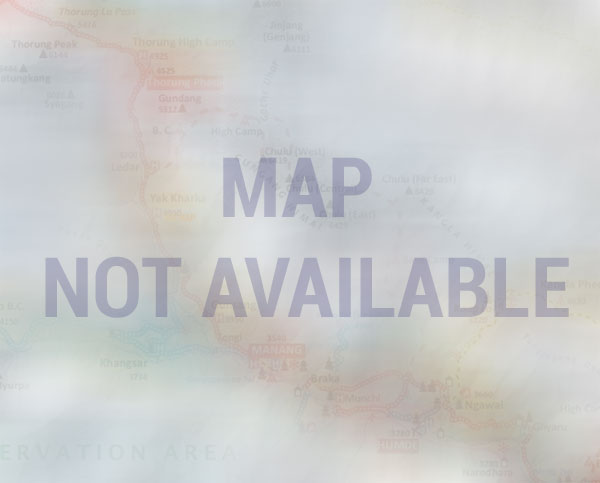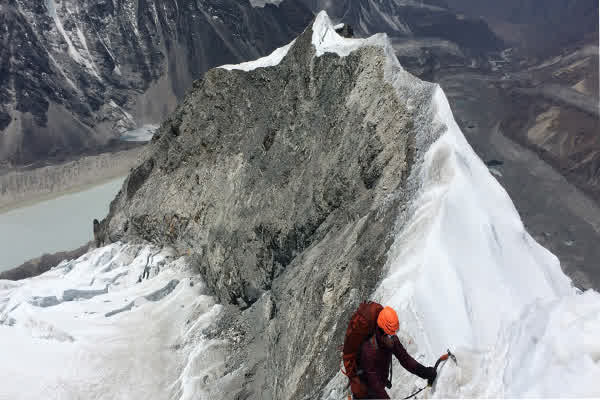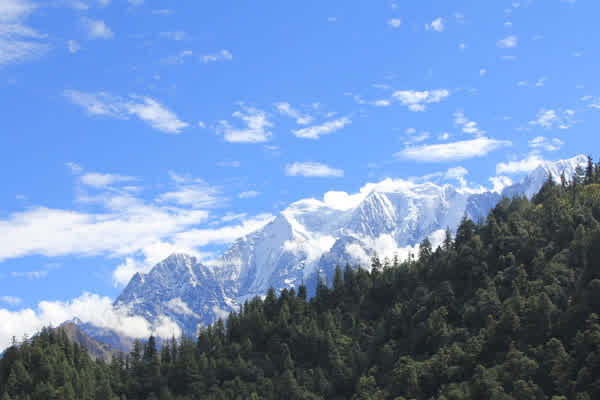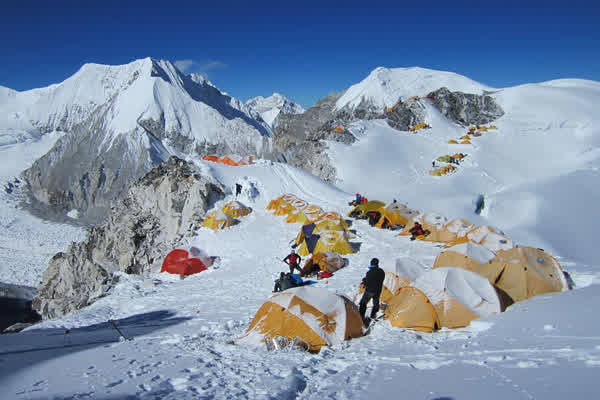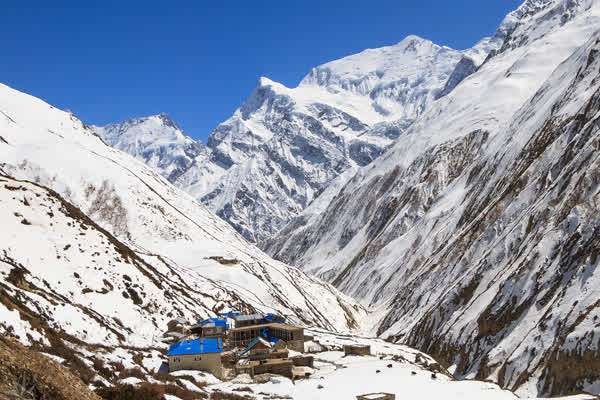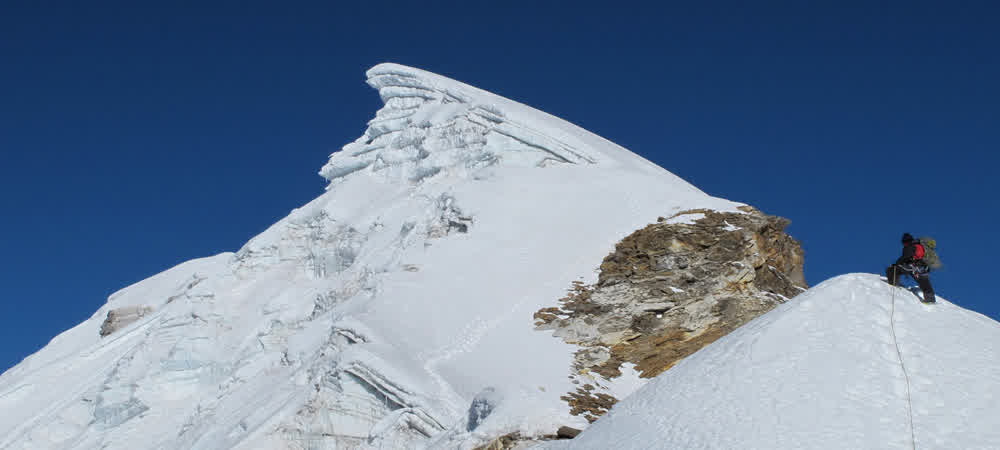
- Overview
- Itinerary
- Price & Dates
- Useful Info
- F.A.Q.
- Gallery
Facts of this Trip
Lobuche peak climbing
Lobuche peak climbing is one of the adventure trekking peak, peak climbing in Nepal. It is a renowned peak for the short adventure seeker, who want to climb peak above 6000m in Everest region. Having wonderful sceneries of snowcapped Himalayan range in the Khumbu region and best destination for the wild adventure and lifetime experience. Peak is standing at 6119 m altitude in the heart of Everest region. It is located in world fantastic and renowned trekking trail Everest base camp trekking.
Lobuche peak can climb from two different ridges. East ridges is well known as Lobuche east peak climbing with 6119 m altitude and west ridges as Lobuche west peak climbing with 6114 m high. Having great opportunity to have summit from both ridges either east or west. Here we develop peak climbing itinerary for the east peak climbing or if you want to climb through west ridges, you may request for that we assure to respond and arrange your expedition.
True East Peak climbing is quite striking and reached by descending into a marked notch, climbing steep snow/ice slopes to the top. Summit of the peak is exposed, often covered with moldy ice. Climbing trip to Lobuche peak climbing offers various existing as well as new and challenging climbing routes to all the amateur climbers and explorers. Climbing to southern Base Camp at an altitude of 5500 meters unfolds stunning views of Mt. Ama Dablam, Mt. Tawache and many more after an acclimatization trek to Kala Patthar and Base Camp. Climb beneath the main glaciers from Lobuche Base Camp to gain access to ridge overlooking Lobuche and Khumbu glacier are breathtaking.
Climbing to Lobuche peak east itinerary is usually develop with the combination of Kalapatthar and EBC trek, thus it is the base options for you having a summit to the highest mountain above 6000M Where you get lifetime experience to see the 360-degree panoramic views of snow-capped Himalaya and many more white peaks surrounding you.
It is one of the popular and most demanding peaks for peak climbing in Nepal. Peak climbing with Everest Trek offers wonderful and majestic views of high Himalayan ranges including Mt. Everest 8848m roof of the world and other many more Himalayas in Everest region over 6000m and 8000 m like Mt. Lhotse (8,516 m), Mt. Cho Oyu (8,201 m), Mt. Nuptse (7,855 m), Mt. Amadablam (6,856 m), Mt. Pumori (7,161 m), Mt. Thamserku (7,723 m). During our trek, our trail passes through the small beautiful settlement of Sherpa the ethnic community and mountainous people in Nepal. Thos who leave in high altitudes in Everest/Khumbu region. You get an opportunity to explore there vivid culture, rituals, lifestyle, enjoy local cuisine and explore alpine diverse flora and fauna and many more.
Lobuche peak climbing starts from the short mountain flight from Kathmandu to Lukla and the continuous to the first leg of the journey trek to Phakding, then next day continue to Namche Bazaar. Where we have a rest day for acclimation on a high altitude. Then continuous trek to Tengboche, Dingboche ahead to EBC after that return to Kala Patthar and continue to Lobuche, climb to high camp at the finally submit the east peak and return back to the same trail.
Trip Itinerary
Arrival at Kathmandu
At your arrival at a Tribhawn international airport, Kathmandu our representative from Alfresco Adventure Travel wait for you outside at Arrival gate with your Name card. Our team will welcome and collect your baggage at the airport. By formal introduction with the representative and then you will be transferred to your hotel. In the evening you will enjoy complimentary welcome dinner in a typical Nepali restaurant with Nepalese cuisine. Overnight at hotel.
Sightseeing around Kathmandu Valley and Pre trek and climbing Preparation
After breakfast, we have short gathering meeting with your trekking guide, supportive staff and Sherpa guide will meet you on the hotel and discuss about all programs and coordinate any last-minute arrangements and settlement. After the staff meeting, one of our professional tour guides will take you on a sightseeing trip and then back to the hotel. Rest of the day can be used for traveling around Thamel and buying any last minute equipment and other necessities. Overnight at hotel.
Fly to Lukla and Trek to Phakding
Lukla is the gateway to Everest Base Camp. After a scenic half an hour flight to Lukla Airport, the journey will begin. The first day of the trek will be more like a warm up. It will take you to Phakding village, just above Lukla. You can spend the rest of the day enjoying the local scenery.
Trek to Namche Bazaar
The trek will ascend up to the Dudh Koshi Valley. After a few hours of hike, you will arrive at entrance of Sagarmatha National Park in Monjo. The next and the final stop will be at Namche Bazaar. Namche is the highlight of the trek. The village bustling with people and lodges feels more like a city.
Acclimatization Day
Higher the altitude, thinner the air! You need to gain altitude slowly and steadily so that we get enough time to acclimatize enroot. Today, you hike to Syangboche village, just above Namche and return back to Namche to spend the rest of the day.
Trek to Dole
After breakfast, you start trekking towards Dole. The trail offers a magnificent view of the great giant snow peaks at Shanasa. You pass through the Mongla hill and continue down towards Phortse Thanga. After a brief stop and lunch, you start walking for few hours before you reach Dole.
Trek to Machhermo
The day begins with an ascent of the scenic ridge above the Dole and it continues to climb along the side of the valley high above the river, crossing sandy spurs until you reach Machharmo. The rest of the day can be spent acclimatizing or visiting around the place.
Trek to Gokyo village
Today, you climb the ridge further up. From here, the valley to Khangtega and northern side Cho-Oyu can be seen. The route descends to the river bank before beginning the climb up to the terminal moraine of the Ngazumpa glacier. Afterwards, the trail levels out as it follows the valley past a second lake, known as Longponga. After an hour, you’ll reach Gokyo village.
Rest Day/Climb Gokyo Ri
Today is a rest day. You can spend time acclimatizing or indulging in a casual outdoor activities. In the morning, you can climb the local peak Gokyo Ri, which doesn’t require any technical climb experience. After the lunch, you can hike to the fifth lake areas passing through the fourth lake and enjoy the surroundings and scenery of the surrounding mountains.
Trek to Thaknak
Today is tough day for trekking. You must cross one of the highest passes in the region, Cho La Pass. You start with a steep climb and continue for a while until the trail drops below Cho La. Afterwards, it’s a steep climb through the rock towards the top. After reaching the top, the trail drops until you reach Dzungla.
Trek to Gorakshep
After a hearty breakfast, you start easy and hike downhill for a while until you reach Lobuche. The trail leads toward the Gorekshep through the rocky trail. You can catch some great views of the Everest, Nuptse and Pumori, along with Kumbu Glacier on the way. After an hour, you will reach Gorekshep and end the day here.
Hike to Everest Base Camp
Today is the special day. You will hike to the Everest Base Camp; therefore, there are many anxieties and surprises. A tough trek through Gorakshep will take you to Everest Base Camp. The day will be the most challenging. You can spend some time exploring the iconic base camp and the surrounding areas, and return to Gorak Shep for the night.
Hike Kala Patthar and Trek to Lobuche
Kala Patthar is the landmark of the Everest. You will start especially early. The reason behind leaving early is to reach Kala Patthar before sunrise. It provides the most wonderful sights of the surrounding along with the Mount Everest. It will take a couple of hours to reach Kala Patthar from Gorak Shep and back. From Gorekshep, you will trek toward Lobuche village. Here, you will meet your climbing guide, and prepare for the upcoming climb
Trek to Lobuche East Base Camp
the next day. Furthermore, you will move towards Lobuche glacier. The scenery along the route is overwhelming with the great views of Ama Dablam, Cholatse, Pokalde, Thamserku and Kantega. Upon reaching to the Base Camp, your guide will set up the tent and the staff will prepare lunch. Afterwards, your guide will instruct you about climbing techniques.
Trek to Lobuche High Camp
Today, you’ll hike to Lobuche High Camp through the rocky moraines and it may take well over 4 hours. Once reached the high camp, you must spend time acclimatizing and prepare for the summit.
Summit Day and Climb back to Base Camp
Today, you’ll have an early start. Everyone will wake up before the dawn and approach for the summit. The staff will prepare a light breakfast, afterwards; it’s a Go for the summit. You will use the South East Ridge for the summit, which will involves walking through the moderate steep snow and ice and may require fix rope to climb. The final ascent is made through the exposed ridge which follow to the final summit.5 to 6 hours of steady climbing will would bring you to the summit of Lobuche East. The view from the summit is simply amazing. It offers the great panoramic view of the entire Khumbu region and the mountains. After the brief cheerful moment, we will climb down to the base camp.
Trek to Pangboche
Today, you will trek back to the Lobuche village and retrace the usual route down to the. After a lunch, you can continue trekking towards the Pangboche village.
Trek to Namche Bazaar
Today, you will return the same way to Namche. You pass through many small hamlets and monasteries on the way to reach Namche Bazaar.
Trek to Lukla
Lukla will be the final stop of our trek. A final leg of the trip, you might overcome with mixed feelings. It’s a day to throw a small party. In the evening we will be celebrations with lot of singing and dancing to succession of our tripe. You will spend the night at Lukla and fly back to Kathmandu early in the morning.
Fly back to Kathmandu
You can take the earliest possible flight back to Kathmandu. One of our representative will transfer you to your hotel. Later in the evening, we will treat you farewell dinner, a set of exquisite Nepalese cuisines.
Final Departure
Today is your last day with us in Nepal. You will access to airport for your onward destination with the unforgettable moment of your life from Lobuche peak climb. Our office representative from Alfresco Adventure Travel came at your hotel for pick up and drop you at the airport. for your onward journey.
Price & Dates
Upcoming Fixed Departure Date and Offer Price.
Trip Cost Includes
- Arrival and Departure by comfortable Private vehicle
- Kathmandu- Lukla - Kathmandu domestic air ticket
- All necessary paperwork, trekking permits, peak climbing permit (National Park Permit, TIMS)
- 3 star accommodation in Kathmandu on BB plan (with breakfast)
- Teahouse accommodation during the trek and camping on peak climbing (Include breakfast, lunch, Dinner)
- Welcome and Farewell dinner in typical Nepal restaurant with Nepal food
- All land transportation is arrange as pre the itinerary in a comfortable vehicle
- City tour in Kathmandu with expert guide by private vehicle
- All entrance fees and government and local charges for sightseeing/monument visits as per the itinerary
- An experienced English spoken and government certified trekking leader, climbing guide and assistant trek leader or guide
- Personal High-Altitude Tents
- Kitchen cookware and staff
- Duffel Bag, T-shirt, Sleeping Bag
- Climbers’ Certificate (Issued by Government)
- Arrangement of Rescue/Medical Helicopter service; covered by your Insurance agency.
- Porter service (2 trekkers = 1 porter)
- Staff cost including their salary, insurance and allowance
- Medical kit (carried by your trek leader or guide)
Group Climbing Gear- We Provide
- Rope, Harness, Ice-axe, Carabineers, Crampons
- F-8, Jumper, Helmet, Ice-Bar, and Ice-screw, Climbing permit
- Tent, foam mattress, sleeping bags, PAC
Trip Cost Exclude :
- Travel insurance (Cover Helicopter evacuation and Trip Cancellation charges)
- Personal Belong items
- Personal expenses, shopping, Beverage bills and so on.
- Tips for staffs
Useful Info
Climbing
EQUIPMENT
Alpine Climbing Harness – A good climbing harness should be light and simple in design, easy to put on and take off with gloves on, with positively foolproof locking features.
Crampons – Crampons must fit boots perfectly; steel crampons with anti-balling and ability to toe point positively and safely into ice. The lighter the better – extra weight on your feet is much more strenuous than anywhere else on your body.
Ice axe – Ice axe should be versatile and light. A general purpose technical ice axe (T rated) but not too aggressive.
Ascender: Ascender or Jamar, a mechanical device used for ascending on a rope; must be suitable to be used with gloves or mittens. Practice using it with thick gloves on again and again.
Multi-LED Head Lamp – Multi-LED Head Lamp and spare batteries are essential; we do not recommend single bulb lights due to lower reliability.
Carabiners – Minimum 2 locking carabineers, 1 large and 1 small and 4 regular.
Rappel Device – Figure 8, ACT or similar; be familiar with Munter Hitch as it may save your life if you lose your rappel device (which happens a lot)
Trekking Poles – Very handy for the approach; adjustable types are the best (preferably with a simple outside locking mechanism)
Slings – One 3m (10ft) and three 2m (6ft)
Prusik loops – Never hurts to carry a few (e.g. 0.6m and 1.2m), they come in handy in many situations
Masks, hoses, and regulators – Good quality for your safety.
Altimeter – ABC watch or more advanced GPS watches will do the trick. Watch for battery life
limbing helmet – Climbing helmet is essential safety gear for crossing areas under rocks and ice cliffs; light weight is essential.
Other items: insect repellent, toilet articles, diary, toilet roll, laundry soap, wet ones, pocket knife, tie cord, towel, sewing kit, plasters, binoculars, camera, film, cards and personal medical kit.
CLOTHING
Upper Body
- 1-2 (medium insulation) short-sleeve Merino shirt (e.g. Icebreaker Merino 150 or lightweight
- 200, Odlo Revolution medium)
- 2 long-sleeve Merino shirts (e.g. Icebreaker Merino 150 and/or 200 or Odlo Revolution, one medium and one thick)
- One fleece pullover, medium weight.
- One fleece jacket.
- One hard-shell waterproof Gore-Tex jacket with large hood to accommodate the climbing helmet. The Arc’teryx SV range is expensive but offers excellent wind and water protection.
- Lightweight down jacket for chilly days in base camp or warm layer when stopping for short breaks.
- One very warm expedition grade goose-down (duvet) jacket with hood or a down suit if you prefer, for high altitude use (e.g. North face, Rab etc.)
Lower Body
- Merino underwear briefs (Icebreaker, Odlo etc.)
- One pair walking shorts Optional
- One pair walking trousers for trekking and around camp
- Two pair thermal Merino bottoms (Icebreaker 150 or 200 or Odlo Revolution)
- One pair very thick thermal Merino bottoms (Icebreaker 200, Odlo Revolution Thick)
- One pair polar fleece trousers or similar mid layer trousers
- One pair Gore-Tex (over)trousers or bibs. Waterproof/breathable with full side zips
- One pair of Goose-down trousers or bibs. You may prefer a down suit (North face, Rab, etc.)
Head
- Warm wool or synthetic hat that covers your ears
- Balaclava or face mask
- Scarf or neck sleeve
- Bandana or head scarf is useful for dusty conditions
- Ball cap or brimmed sun cap
- Glacier Sunglass with side shields (2x)
- One pair of ski goggles (optional with light and dark lens) for windy conditions
Hands
- One pair lightweight liner gloves. These will be worn when tying knots etc.
- Mitten: Goretexovermitts (that block the wind) matched with the very warm down mitts, spare mitts might also be useful (For instance, Mountain Equipment Redline)
Feet
- One pair of plastic boots suitable for >8000m. (For instance La Sportiva Olympus Mons, Millet or equivalent good quality plastic shells with inner boots; avoid tight fit with heavy socks)
- One pair sturdy leather or synthetic (Gortex) hiking boots with good ankle support for the walk to base camp
- One pair cross-trainers, running shoes and/or sandals for Kathmandu and in camp
- One pair down booties Optional
- Two pair med-heavy poly or wool socks
- Two Pair of liner socks. Polypropylene or wool
- Vapor barrier liner socks or plastic bread-bags (matter of preference)
- Two pair lightweight trekking socks, poly or wool
- Light Merino wool or cotton socks for in town
Frequently Asked Questions.
Media Gallery
Please click on small photos to have larger view.

